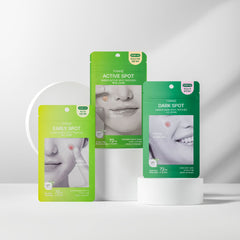The DNA of Skincare: AHA vs BHA Exfoliants

In this article :
The difference between the hydroxy acids AHA and BHA
Choosing the right hydroxy acid exfoliant & when to use them

At FRANZ Skincare, the science behind our beauty tech is what sets it apart. After all, we do offer the world’s first microcurrent face mask. So, it may be no surprise that we’re obsessed with the ingredients that go into our skincare that are delivered through our innovative system. Since we don’t expect everyone to be as science obsessed as us, we’re introducing a new series of posts called The DNA of Skincare, breaking down active skin care product ingredients we’re obsessed with for overall improved skin. Consider us your skincare ingredients dictionary. Today we’re breaking down everything you need to know about alpha hydroxy acids vs beta hydroxy acids.
What are alpha hydroxy acids (AHA) and beta hydroxy acids (BHA)?
Let’s start with the basics: both AHA and BHA are acids that act as chemical exfoliants and are meant to remove dead skin cells and clean out your pores. Unlike the exfoliate scrubs that are meant to manually sloughed off dead skin cells, AHAs and BHAs break up the bonds of the dead skin allowing the cells to fall away.
Overview of the differences between AHAs vs BHAs
| AHA | BHA |
|---|---|
| derived from plants, milk, and commonly sugar cane | derived from bark and leaves |
| water-soluble | oil-soluble |
| great for surface level concerns like anti-aging, acne-scarring, fine lines and wrinkles, pigmentation issues; a great exfoliant that sheds dead skin cells; stimulates collagen production | great for deeper skin penetration and provides antibacterial and anti-inflammatory help; used for treating blemishes, oily skin and acne |
What are the benefits of using AHAs and BHAs in skincare?
While there are definite differences between AHAs and BHAs, they actually share a lot in common, since they both exfoliate the skin.
- Brightening: Without the layer of dead skin dulling your face, your face will reflect more light, making your skin tone appear brighter. Smoothing: as a side effect of great exfoliation, AHAs and BHAs can make your skin appear and feel smoother.
- Reducing fine lines and wrinkles: both AHAs and BHAs have shown to increase collagen production, which could fill in fine lines and wrinkles with use over time.
- Mild acne prevention and control: Since we know dead skin cells lead to clogged pores and acne, using AHAs and BHAs could control acne caused in this manner.
Which acids are AHAs?
- Glycolic acid
- Lactic acid
- Mandelic acid
- Malic acid
- Tartaric acid
- Citric acid
Which acids are BHAs?
- Salicylic acid
- Betaine salicylate
- Salix alba or Willow Bark Extract
What is AHA and what are its benefits?
 AHA stands for alpha-hydoxy acid. AHAs are derived from plants, milk, and commonly sugar cane. If you have sensitive or dry skin, you might prefer an AHA, as they are typically more hydrating. If your top goal is anti-aging, you may want to choose an AHA. Specifically, if your concern is fine lines and wrinkles, AHAs have been shown to help stimulate collagen and produce changes in dermal thickness and the depth and number of fine lines and wrinkles.
AHA stands for alpha-hydoxy acid. AHAs are derived from plants, milk, and commonly sugar cane. If you have sensitive or dry skin, you might prefer an AHA, as they are typically more hydrating. If your top goal is anti-aging, you may want to choose an AHA. Specifically, if your concern is fine lines and wrinkles, AHAs have been shown to help stimulate collagen and produce changes in dermal thickness and the depth and number of fine lines and wrinkles.What are the side effects to AHAs?
Using AHA products safely and as directed is important, as AHAs have been shown to be more drying and can cause irritation. AHAs increase your skin's sensitivity to the sun and are skin-wounding agents, so we highly recommend using AHAs a few times a week instead of daily.
What is BHA and what are its benefits?
BHA stands for beta-hydroxy acid. These acids tend to be derived from bark and leaves. Because they are oil soluble, they are ideal for those with oily skin or combination skin, reducing oil production by slowing down oil secretion. For this reason, they are even better at clearing and preventing acne. It’s also gentle enough to be used on those with sensitive skin, and have photoprotective effects (but still, don’t skip the sunscreen). It can also be used to fight bacteria and help reduce calluses.
How should I apply an AHA or BHA skincare product?
AHAs and BHAs come in a large range of forms from serums to masks to toners. Because the AHAs and BHAs are chemical exfoliants, you shouldn’t need to scrub it into the surface of your skin, unless otherwise instructed. When it comes to applying any skincare, we always suggest gentle circular motions, unless the product specifically calls for something different. Because AHAs and BHA products can be drying, we recommend following up with your favorite hydrating products and avoid using it with other hydration stripping products.
Can I use AHAs or BHAs daily?
Even though BHAs are typically better for sensitive skin, we don’t recommend using AHAs or BHAs more than a few times a week. We also recommend using AHA and BHA products with a great moisturizer and to not pair them with witch hazel, which can be very drying as well.
Choosing the right exfoliant for your skin
Choosing the right chemical exfoliant for your skincare really comes down to your skin type and goals, but we love these acids as any part of a bright, clear, healthy skin routine!

